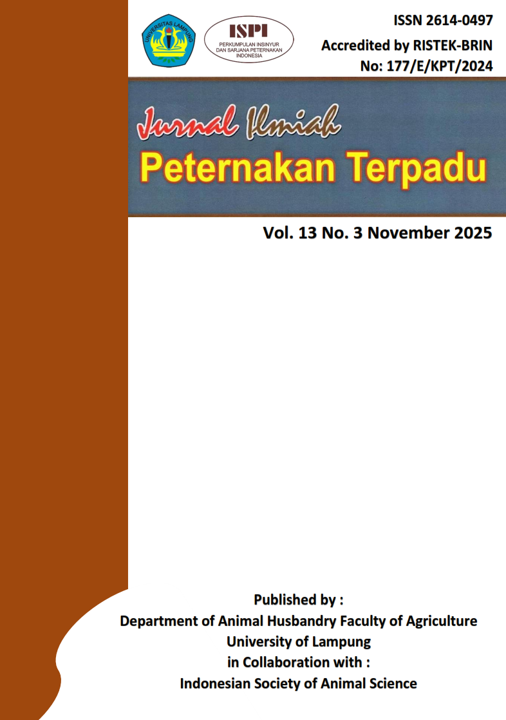Utilization of Sambiloto Extract Encapsulation with Foam Mat Drying Method in Drinking Water on Broiler Carcasses
DOI:
https://doi.org/10.23960/jipt.v13i3.p746-760 Abstract View: 44
Abstract View: 44
Abstract
This study aimed to evaluate the effect of Encapsulated Extract of Andrographis paniculata Leaves (EEOAPL), dried using the foam mat drying method and administered through drinking water, on the performance and carcass quality of broiler chickens. A total of 100 day-old broiler chicks were reared for five weeks in an open-house system using a Completely Randomized Design (CRD) with five treatments: A0 (commercial feed without extract), A1 (basal feed without extract), A2 (basal feed + 0.4% EEDS), A3 (basal feed + 0.8% EEDS), and A4 (basal feed + 1.2% EEDS). Each treatment was replicated four times with five birds per replicate. The results showed that final body weight ranged from 1503.25 g to 1896.50 g per bird, carcass percentage from 68.26% to 72.49%, abdominal fat from 1.435% to 1.553%, and performance index from 292.61 to 397.68. Statistical analysis revealed that EEDS supplementation had a highly significant effect (P<0.05) on final body weight, carcass percentage, and performance index, but no significant effect (P>0.05) on abdominal fat.
Downloads
Downloads
Published
How to Cite
Issue
Section
License
Copyright (c) 2025 Nilawati Nilawati, Agustina Agustina, Nelzi Fati, Debby Syukriani, Toni Malvin

This work is licensed under a Creative Commons Attribution 4.0 International License.

Jurnal Ilmiah Peternakan Terpadu(JIPT) is licensed under a Creative Commons Attribution 4.0 International License.
Authors who publish with this journal agree to the following terms:
- Authors retain copyright and grant the journal right of first publication with the work simultaneously licensed under a Creative Commons Attribution License that allows others to share the work with an acknowledgement of the work's authorship and initial publication in this journal.
- Authors are able to enter into separate, additional contractual arrangements for the non-exclusive distribution of the journal's published version of the work (e.g., post it to an institutional repository or publish it in a book), with an acknowledgement of its initial publication in this journal.
- Authors are permitted and encouraged to post their work online (e.g., in institutional repositories or on their website) prior to and during the submission process, as it can lead to productive exchanges, as well as earlier and greater citation of published work (See The Effect of Open Access).





















